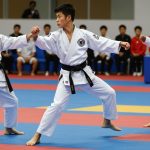Safety in the gym is a critical aspect for every fitness enthusiast. When it comes to training alone, this becomes even more important to ensure no unwanted injuries occur. In this article, we’ll outline the key strategies for ensuring a safe workout when you’re flying solo at the gym. We’ll discuss the importance of proper form, warm-ups, using equipment correctly, listening to your body and understanding the risk factors associated with specific exercises.
Understanding and Maintaining Proper Form
Even before you step foot in the gym, you should have a clear understanding of the proper form for every exercise in your workout routine. Doing so not only maximizes the effectiveness of your training but also significantly reduces the risk of injuries.
Also to see : What are the implications of high-protein diets on kidney health for bodybuilders?
To gain a clear understanding of proper form, start by researching the exercises you plan to add to your workout regimen. There are numerous resources available online, including video tutorials, articles, and guides that can provide detailed instructions on maintaining correct posture and technique.
Remember, it’s not about how much weight you can lift, but rather how you lift it. Prioritize form over weight. Your muscles will thank you, and you’ll significantly lower your risk of getting injured.
In the same genre : What are the biomechanical effects of varying ankle positions during calf raises?
In addition to doing your research, consider consulting with a fitness professional. They can provide personalized advice and correct any mistakes in your form before they contribute to an injury. If this isn’t possible because you’re training alone, consider filming yourself during your workout. This can provide valuable feedback, as you can review the video and spot any deviations from proper form.
The Importance of Warm-ups
Warm-ups are a critical yet frequently overlooked component of safe workouts. Neglecting to warm up before strenuous exercise increases the risk of pulling a muscle or causing other injuries.
Before beginning your workout, dedicate at least 5-10 minutes to a dynamic warm-up. This includes activities like jogging, jumping jacks, or bodyweight exercises that gradually increase your heart rate and circulation. This process helps prepare your body for the workload ahead, enhancing muscle elasticity and flexibility.
In addition to a dynamic warm-up, consider specific warm-up sets for the exercises you’re planning to perform. For example, if you’re planning to bench press, start with a lighter weight to prepare your muscles and joints for the heavier sets ahead.
Utilizing Gym Equipment Correctly
Gym equipment can be a double-edged sword. When used correctly, it offers a beneficial and intense workout, but when used improperly, it poses a significant risk of injury.
If you’re unfamiliar with a piece of equipment, don’t hesitate to ask for help or find information online. Most gym machines come with instructions printed directly on them. However, these can be confusing or unclear, especially for beginners. In such cases, it’s best to consult a trainer or search for a demonstration video online.
When using weights, be extra cautious. Never attempt to lift a weight that you cannot safely handle. Using excessively heavy weights not only compromises your form but also poses an urgent safety risk.
Listening to your Body
No one knows your body better than you do. If something doesn’t feel right during an exercise, it likely isn’t. Ignoring pain or discomfort can result in serious injuries.
Pain signals that the body is being pushed beyond its limits. It’s crucial to differentiate between the burn of a challenging workout and the pain associated with injuries. If you’re feeling the latter, it’s time to stop.
Don’t let your ego make decisions at the gym. Pushing through pain isn’t a sign of determination or grit—it’s a dangerous habit that could lead to long-term health problems.
Recognizing the Risk Factors of Specific Exercises
Every exercise carries a certain level of risk, with some being riskier than others. It’s essential to recognize these risks and take necessary precautions.
For instance, exercises like deadlifts or squats require excellent form to execute safely. These exercises can lead to serious injuries, including herniated discs, if done incorrectly.
Make sure you understand the potential risks associated with your exercises and how to mitigate them. This information becomes even more important when you’re training alone, as there’s no one around to spot any mistakes or come to your aid during an emergency.
Training alone in the gym can be empowering, allowing you to focus entirely on your workout. However, it also comes with increased responsibility. Emphasizing safety ensures that you remain injury-free and can continue pursuing your fitness goals unimpeded.
Developing Age-Appropriate Training for Young Athletes
There has been a rise in the number of young athletes involved in strength training in recent years. Properly supervised and age-appropriate strength training can be beneficial for young athletes. However, there are critical considerations to keep in mind to ensure health safety.
Growth plates in young athletes are areas of developing cartilage tissue. They are more vulnerable to injury than the muscles and tendons. Overdoing strength training or doing it incorrectly can lead to serious damage to these growth plates, causing long-term complications. Thus, the importance of correct exercise safety for young athletes cannot be stressed enough.
When it comes to young athletes, the focus should not be on lifting heavy weights. Instead, the emphasis should be on mastering the proper form and technique of each exercise. For instance, before using a squat rack or bench press, young athletes should be confident in their ability to perform the exercise with free weights.
Young athletes should begin strength training under the guidance of a qualified personal trainer. A trainer can provide instruction on proper form and ensure the safe use of exercise equipment. Moreover, the trainer can help young athletes understand the importance of listening to their body and not pushing beyond their limits.
Besides, the strength training program for young athletes should involve working all muscle groups. It’s not about isolated muscle group training, but about overall strength and fitness. The program should also include a mix of weight training and cardiovascular exercises.
In conclusion, when it comes to young athletes, the key to ensuring safety in the gym is proper supervision, correct form, balanced training, and understanding their unique needs and limitations.
The Role of Proper Equipment Use and Maintenance
The use and maintenance of equipment is an integral part of ensuring safety when training alone in the gym. Whether it’s the squat racks, the bench press, the weight plates or the free weights, each piece of equipment comes with its usage guidelines and safety measures.
Firstly, always check the equipment before you start. Inspect the equipment for any signs of wear and tear. Loose cables, worn-out padding, or cracked weight plates are potential hazards. Immediately report any damaged equipment to the gym authorities and avoid using it.
Secondly, remember to re-rack your weights. Leaving weight plates or free weights lying around is a tripping hazard. Not only does this pose a risk to you, but it’s also a danger to others who use the gym.
Thirdly, always use safety clips while using barbells. These clips help keep the weight plates in place, reducing the risk of weights sliding off and causing injuries.
Lastly, ensure the proper use of exercise equipment. Using equipment incorrectly not only reduces its effectiveness but also increases the risk of injury. If you’re unsure about how to use a piece of equipment, ask a gym staff member or look for information online.
Using gym equipment safely and properly is a responsibility that every gym-goer must take seriously. It’s an essential part of maintaining a safe and healthy workout environment.
Conclusion
Gym safety is not a topic to be taken lightly, especially when you’re training alone. It’s a blend of proper form, adequate warm-ups, correct use of equipment, listening to your body, and understanding the risk factors of exercises. For young athletes, the focus should be on age-appropriate training, proper supervision, and balanced workouts.
Remember, the ultimate goal is health and fitness. It’s not about how heavy you can lift, but how well you can lift it. A good workout is one that leaves you feeling stronger and healthier, not injured and discouraged. Stay safe, stay fit!











